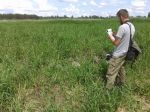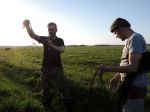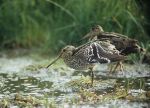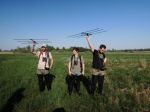Great snipes: always amazing
06 grudzień 2013
 The first season of studies devoted to habitat selection and the usage of space by great snipes in the upper Narew River Valley has been closed successfully, bringing many interesting observations. From the researcher's point of view, the acquired information sheds new light on the behaviour of this mysterious species. For us it is also an invaluable contribution to the problem, which habitants, characterized by what type of structure, is preferred by the great snipe. This will help us to plan and perform conservation activities in the upper Narew River Valley more effectively. Below we present the scope of this year's studies and a number of associated interesting facts.
The first season of studies devoted to habitat selection and the usage of space by great snipes in the upper Narew River Valley has been closed successfully, bringing many interesting observations. From the researcher's point of view, the acquired information sheds new light on the behaviour of this mysterious species. For us it is also an invaluable contribution to the problem, which habitants, characterized by what type of structure, is preferred by the great snipe. This will help us to plan and perform conservation activities in the upper Narew River Valley more effectively. Below we present the scope of this year's studies and a number of associated interesting facts.
 In the upper Narew River Valley, 8 active leks have been discovered, with the total number of 39-45 males. With respect to known and historical leks, 2 new ones have been found, and 2 others, known from previous lekking seasons, were not in use. The absolute number of males could supposedly be higher, as, following prolonged spring floods, substantial fluctuations of the number of males have been observed, and some of them even ceased their activity.
In the upper Narew River Valley, 8 active leks have been discovered, with the total number of 39-45 males. With respect to known and historical leks, 2 new ones have been found, and 2 others, known from previous lekking seasons, were not in use. The absolute number of males could supposedly be higher, as, following prolonged spring floods, substantial fluctuations of the number of males have been observed, and some of them even ceased their activity.
 During 8 captures carried out on great snipes leks in order to deploy telemetric devices, a total of 43 individuals have been captured (39 males and 4 females). Most of theese activities took place in the upper Narew River Valley, however, in order to collect data, which will serve in the preparations of the National Conservation Pplan, 3 captures took place in the Special Protection Areas of the Knyszyń Forest and Biebrza Refuge (Ostoja Biebrzańska). All great snipes have been ringed, measured and fitted with a device suitable for the performed studies. Directly after the transmitters had been deployed, the birds returned to the lek, where they could pursue the courtship.
During 8 captures carried out on great snipes leks in order to deploy telemetric devices, a total of 43 individuals have been captured (39 males and 4 females). Most of theese activities took place in the upper Narew River Valley, however, in order to collect data, which will serve in the preparations of the National Conservation Pplan, 3 captures took place in the Special Protection Areas of the Knyszyń Forest and Biebrza Refuge (Ostoja Biebrzańska). All great snipes have been ringed, measured and fitted with a device suitable for the performed studies. Directly after the transmitters had been deployed, the birds returned to the lek, where they could pursue the courtship.
 Fieldwork associated with habitat selection has consumed 262 person-days in total. During that time, great snipes were tracked using the VHF telemetry. Data concerning the habitats was collected in over 90 sites, where the great snipes foraged, and over 150 randomly selected localities. In each of these sites no less than 11 habitat parameters were recorded. For entomological investigations, over half a ton of soil samples have been collected. As foraging sites, great snipes preferred localities with pasturing animals, not only cows and horses, but also European bisons.
Fieldwork associated with habitat selection has consumed 262 person-days in total. During that time, great snipes were tracked using the VHF telemetry. Data concerning the habitats was collected in over 90 sites, where the great snipes foraged, and over 150 randomly selected localities. In each of these sites no less than 11 habitat parameters were recorded. For entomological investigations, over half a ton of soil samples have been collected. As foraging sites, great snipes preferred localities with pasturing animals, not only cows and horses, but also European bisons.
 Out of 9 installed GPS transmitters, 8 yielded data – altogether approximately 2500 positions. Thanks to them, we have discovered that the record-holding male visited at least 3 (possibly 4!) leks, covering the distance of over 40 km. It is noteworthy that a part of the males was strongly faithful to one lekking arena, whereas others adapted a completely different strategy, which consisted of visiting several leks during one night.
Out of 9 installed GPS transmitters, 8 yielded data – altogether approximately 2500 positions. Thanks to them, we have discovered that the record-holding male visited at least 3 (possibly 4!) leks, covering the distance of over 40 km. It is noteworthy that a part of the males was strongly faithful to one lekking arena, whereas others adapted a completely different strategy, which consisted of visiting several leks during one night.
 Another investigated individual has visited Belarus, thus covering over 120 km both ways. What is interesting, it probably stayed there longer than in Poland, therefore a part of the Belarussian population has essentially been encompassed in the study by accident :). We can only hope that the information about the great snipe with a transmitter will not raise suspicions of the Belarussian authorities and we will not be accused of spying .
Another investigated individual has visited Belarus, thus covering over 120 km both ways. What is interesting, it probably stayed there longer than in Poland, therefore a part of the Belarussian population has essentially been encompassed in the study by accident :). We can only hope that the information about the great snipe with a transmitter will not raise suspicions of the Belarussian authorities and we will not be accused of spying .
 We have to wait for the return of great snipes from their wintering sites to learn the results of studies employing geolocators. We will get to know the itinerary they have covered on the way to Africa, and – who knows – maybe even to somewhere else... We cannot wait for the spring already, so that we could find out! We will report further discoveries, some of which are already taking shape, after a more detailed processing of the collected material. To sum up, it should be emphasized that safety of the birds was a priority for us, therefore we are happy that not a single great snipe has suffered from our investigations.
We have to wait for the return of great snipes from their wintering sites to learn the results of studies employing geolocators. We will get to know the itinerary they have covered on the way to Africa, and – who knows – maybe even to somewhere else... We cannot wait for the spring already, so that we could find out! We will report further discoveries, some of which are already taking shape, after a more detailed processing of the collected material. To sum up, it should be emphasized that safety of the birds was a priority for us, therefore we are happy that not a single great snipe has suffered from our investigations.


